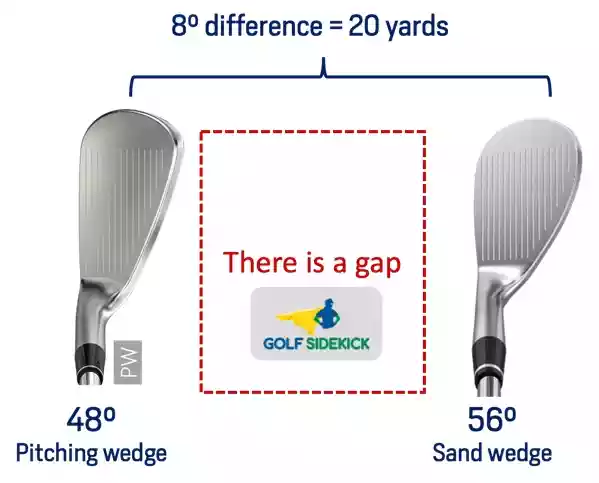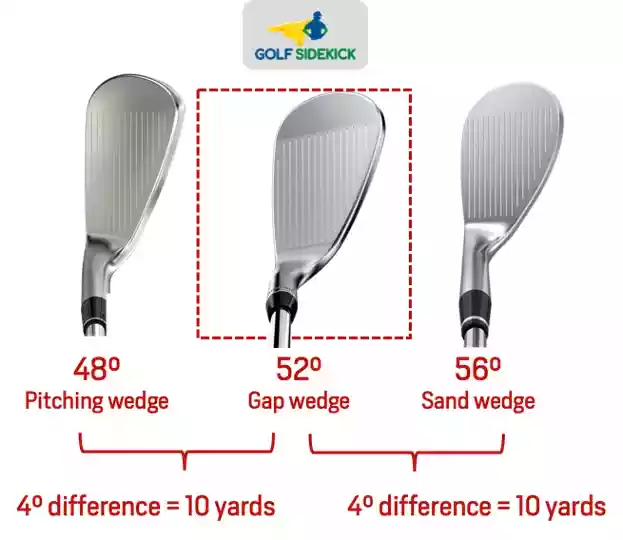Last Updated on December 26, 2023 by Matt Greene
Are you confused about when to use that weird club? It's not a sand wedge, it's not a pitching wedge so when do you use it? When I first stated playing golf in 1997, the concept of gap wedges didn't exist. You had a pitching wedge and then you had a sand wedge and that was that.
But then, approach wedges and gap wedges were born. Finally here's a golf club which bridged the big gap in yardage between the pitching wedge (46°)‚ and sand wedge (56°)! Now we can plug the distance gap nice and easy learning when to use a 52 degree wedge. No more hard sand wedge hits, no more lazy, pulled pitching wedges - just committed swings all day.
I think of a gap wedge like a hybrid. It's a club designed to give you more options and flexibility in the scoring section of the golf bag.
What is a 52 degree wedge?
A 52 degree wedge is also known as a gap wedge. You will most likely have an 8 to 10 degree difference between the pitching wedge and sand wedge in your golf bag. The 52 lets you fill the "gap" between your pitching wedge and sand wedge and give you more versatility for scoring shots.
A gap wedge will be a specialist wedge you have to either select as an extra to a set of irons or buy separately. All of the main iron and wedge manufacturers, from Cleveland golf to TaylorMade, produce a selection of 52 degree wedges for you to choose from. The top manufacturers also offer a variety of finishes, bounce options and sole grinds so you can find the best gap wedge for you.
Gap wedges look like a sand wedge but with 4 degrees less loft. The shaft length is around 37.5 inches. Most gap wedges have a steel shaft, but it's becoming more common for a lot of slower swinging golfers to put a graphite shaft in their wedges.
I recommend replacing you wedges every year if you play regularly - more than 3 times per week. New wedges have sharp grooves which provide consistent spin and therefore better control on your shots. Other options are to get a groove sharpening tool.
Now we know what a 52 degree wedge is, let's look at when you would want to use one out on the course.

When Should You Use A 52 Degree Wedge? 4 scenarios
- When your yardage to the hole is between your pitching wedge and sand wedge
- When you want a lower trajectory for chipping
- For long green side bunker shots
- Shots into the wind from 110 to 120 yards from the green
Scenario 1: Filling the gap between you pitching wedge and sand wedge
Tell me a secret and I won't repeat it: when was the last time you put in some serious practice to improve your golf game? If you're like most golfers who prefer to spend their valuable free time at the golf course rather than the driving range, my secret for you is that the gap wedge was designed for you.
Seriously, it takes time and practice (or a lot of natural feel) to be able to add and subtract yardage off clubs at will off your pitching wedge or sand wedge. A 52 degree wedge means no more difficult half shots with a pitching wedge or attempting to muscle a 56 degree. You make the same committed swing with each club, knowing that you should hit your desired number.
Plugging this yardage gap between your two scoring wedges is probably the best reason to add a 52 degree to your golf equipment. The average golfer hits their pitching wedge 110 to 120 yards and carry their sand wedge 90-95 yards. A 25 yard gap between clubs is not seen much anywhere else in the bag, so why would you have this situation with your money making clubs?
A 52 degree gap wedge will give you a solid option for those tricky yardages that we always leave ourselves. If you find yourself cursing every time you get that damn distance right between the pitching wedge and sand wedge, grab a gap wedge ASAP.

Scenario 2: A lower trajectory chipping club
Amateur golfers are always in awe of PGA professionals hitting low chips which look like they are going too fast to hold the green, only to check up and stop by the hole. A 52 degree wedge isn't the secret to this type of shot, but it will help you hit the ball lower around the greens and get it rolling on the putting surface quicker. It's an essential short game club in my opinion.
Say you've left the ball a few yards short of the green and the pin is on the back tier. Yes you could try and fly it all the way back with a sand wedge or lob wedge, but this is a high risk shot if you don't practice it intently. It's usually better to get the ball on the the green as fast as possible and let it roll up to the pin. This bump and run style shot with a gap wedge is something I use a lot when there's sticky rough in front of me or when I can't use a 9 iron. Try this shot out with a 52 degree and see if it works for you.
Scenario 3: Awkward long green side bunker shots

I might be the exception to the rule when it comes to bunker shots because I love them. Most players hate being left with a 20-30 yard shot from the sand, and ironically, it's what probably makes their ball seem magnetic to the traps!
Being a wizard from the sand makes you not fear being in sand bunkers and therefore means you are less likely to end up in one. That's just science.
Like the bump and run shot described in scenario 2, the 52 degree wedge allows more versatility from bunkers as you are playing with less loft. The great thing is, you don't have to make a different swing. You can hit the same bunker shot that you would with your sand wedge or lob wedge. Smack the sand behind the ball and watch as the ball pops out lower and further, with more roll out.
Having multiple loft options around the greens and in bunkers is essential when you're trying to slash your scores and get to the lower handicap.
Scenario 4: Full wedge shots into the wind from your sand wedge distance
When you have a shot which is your usual sand wedge distance, being able to pull out the 52 with the wind into your face is a great option. Sand wedges produce high spin and if you hit them hard, they spin even more. If you hit them hard into the win, the spin plus the wind can reduce their distance up to 40 yards. This added spin will cause the ball to balloon up in the air, leaving it way short of your target.
The trick here is to loft down and swing easy to minimize the spin rate. When you swing a bit softer, you put a few less revolutions on the ball, which allows the ball to penetrate the wind instead of being caught by it. You can be confident that your 52 degree wedge has enough loft to maximize your spin and allow the golf ball to grab on the green when landing without getting sucked in by the breeze.
Never fear full shots with a wedge in windy conditions again!

52 degree gap wedge distance
On a full shot, average golfers would expect to carry their 52 degree gap wedge between 100-120 yards. This is always dependent on you swing and ball speed but you will most likely be somewhere in this range.
The whole point of a gap wedge is to give you a yardage option between your pitching and sand wedges. If you are hitting any of these clubs a similar distance, it would be would be worth seeing a PGA professional to work out where you can make improvements. A lot of times, the bounce of the club combined with the loft can make a big difference in distance and spin rates.
The top wedge fitters can optimize your loft, bounce and weight of your wedges. If you're a mid handicapper looking for a good wedge check out my guide and see which are the best gap wedges. High handicappers these are the best wedges for you.
More Options to a 52 Degree Wedge - do I need a lob wedge?
If the gap wedge doesn't sound like the club you need, but a higher loft option is what you want, you could go for a setup like this:
- 48 degree pitching wedge
- 54 degree sand wedge
- 60 degree lob wedge
The lower lofted sand wedge could act as a kind of gap wedge in this scenario but it will take some skill and manipulation off the club face on some shots.
If the 52 degree sounds good, try this wedge configuration :
- 48 degree pitching wedge
- 52 degree gap wedge
- 56 degree sand wedge
- 60 degree lob wedge
You could cut it down to 3 clubs too:
- 46 degree pitching wedge
- 52 degree gap wedge
- 58 degree lob or sand wedge
I would say that going for a gapping session on a launch monitor like a TrackMan is really useful when trying to work out your wedge setup. You may find that two clubs are pretty bunched in terms of yardage. Even better would be to see a wedge fitter o a grass range where the grass is similar to your course conditions. By that, I mean don't get fitted for wedges on Florida bermuda grass, when you play cool weather bent grass and ryegrass fairways!
This isn't a disaster as you may want a specific wedge for certain short game shots or turf conditions. For example on a recent links golf trip, I added a lower bounce 60 degree wedge for partial shots on tight lies. I never intended to hit a full shot with it.
Final Thoughts: Should I Carry a 52 Degree Wedge
It wasn't that long ago that the gap wedge wasn't even an option for golfers. You were forced to make a half swing with your pitching wedge or muscle a sand wedge to nail that in between yardage and this could often end in disaster.
I think the 52 degree wedge or another gap wedge should be in every golfer's bag. As we have covered, it can be used for everything from chip shots to long bunker splashes and can give you consistent performance in the wind. It's a versatile club.
Head down to your local golf store and use this information to find the best gap wedges for you.
